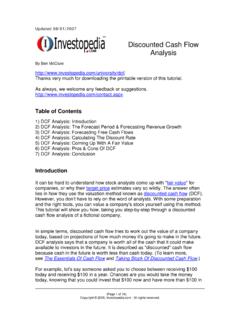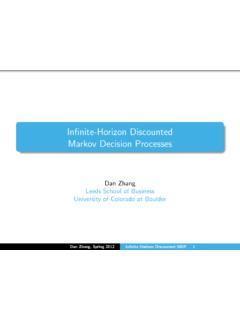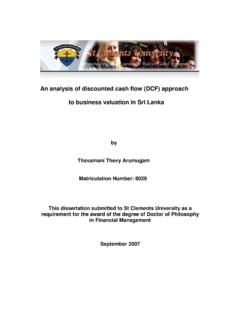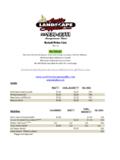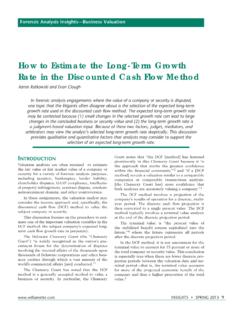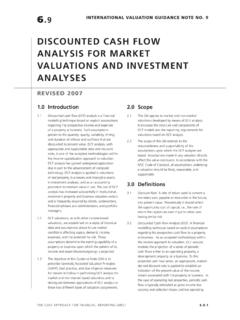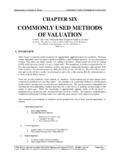Transcription of Discounted Cash Flow Methodology - Graham And …
1 Discounted Cash Flow Methodology Table of Contents Section 1 Discounted Cash Flow Overview CONFIDENTIAL DCF Primer Section 1. Discounted Cash Flow Methodology Discounted Cash Flow Overview The DCF approach values a business based on its future expected cash flows Discounted at a rate that reflects the riskiness of the cash flows . Forecasting Free Estimating Cost Estimating Terminal Calculating and Cash Flow of Capital Value Interpreting Results Identify components of Develop target capital Determine the Develop results. free cash flow. structure. relationship between Perform sensitivity terminal value and cash Develop historical Estimate cost of equity. analyses. flow ( , enterprise perspective. Estimate cost of non- value as a multiple of Interpret results within Determine forecast equity sources of capital. EBITDA, P/E multiple, decision context. assumptions and FCF perpetual growth scenarios. rate, etc.). Decide forecast Estimate terminal value horizon. ( , continuing value Prepare the forecast.)
2 Beyond forecast horizon). Discount to the present. CONFIDENTIAL Draft of DCF Primer , printed 1/25/2005 6:20 PM 1. Discounted Cash Flow Methodology Advantages and Disadvantages of DCF. DCF is more flexible than other valuation approaches in considering the unique circumstances of a company, but it is also very sensitive to estimates of cash flow, terminal value and the discount rate. Advantages Disadvantages Provides an objective framework for assessing a Extremely sensitive to cash flow projections which may be company s risk and cash flows to estimate value. inherently difficult to predict, particularly as the projection horizon lengthens. Requires users to think about key drivers of value. Terminal value may be distorted by incorrect estimations of either cash flow or terminal multiples. May be used when no pure play comparable companies Validity of the discount rate depends on assumptions for are available. beta and the market risk premium. CONFIDENTIAL Draft of DCF Primer , printed 1/25/2005 6:20 PM 2.
3 Discounted Cash Flow Methodology Cash Flow Projections Discounted cash flow analysis is extremely sensitive to cash flow projections. Use a realistic management case which has been thoroughly diligenced. Forecast favorable and unfavorable scenarios as sensitivity cases, and probability weight each scenario to achieve expected value. If practical, the forecast horizon should reflect the time it takes for the firm to reach a steady state. The forecast horizon should generally reflect the time it takes for a company to achieve stable growth, stable capital structure or an end to restructuring. The forecast period should not extend beyond such time frame as the company can reasonably project. Since cash flows are generated over the course of each year (rather than at the end of each year), the cash flows during each year of the forecast should be Discounted back from the mid-year to time zero for non- seasonal businesses. Assumes that cash flows occur at the mid-point of each year and, consequently, cash flows in year 1 are Discounted year, cash flows in year 2 are Discounted 1 years, etc.
4 For certain industries characterized by greater seasonality, an end-of-year discounting convention (or other reasonable assumption) may be more appropriate. CONFIDENTIAL Draft of DCF Primer , printed 1/25/2005 6:20 PM 3. Discounted Cash Flow Methodology Free Cash Flow Approach An approach to calculate the unlevered value of the firm is to use after-tax, debt-free, nominal Free Cash flows to the Firm. The approach of measuring free cash flows to the unlevered firm permits us to ascertain the operating value of a firm independent of its capital structure. Provides a greater degree of analytical flexibility. The value of equity is calculated as the value of the firm s operations less the value of its net debt and other non-equity claims such as preferred stock and minority interests. Under this approach, FCF to the Firm ( FCFF ) are Discounted at the Weighted Average Cost of Capital ( WACC ). The value of the debt can be estimated by the lesser of market value or book value.
5 In-the-money convertibles should not be included as debt for this calculation since they are assumed to have been converted. Alternatively, the DCF template is sufficiently flexible to calculate a company s equity value from the FCF to Common Equity ( FCFCE ) after deducting after-tax debt service, preferred dividends and changes in debt, preferred stock and minority interest. Under this approach, FCFCE are Discounted at the Cost of Equity ( KE ). In general, make sure the subject company s dividend policy is consistent with the discount rate and cash flow assumptions. If the dividend payout ratio changes, operating performance (and cash flows ) should also change. If all free cash flows are assumed to be distributed to shareholders, make sure that retained earnings are not double-counted by reinvesting cash. CONFIDENTIAL Draft of DCF Primer , printed 1/25/2005 6:20 PM 4. Discounted Cash Flow Methodology Defining Free Cash Flow Top-Down Approach Earnings before interest and taxes (EBIT) Consolidated operating income related to the subject operations.
6 Subtract adjusted taxes Calculated by multiplying the marginal tax rate by EBIT after adding back items which are not tax deductible such as non-deductible goodwill amortization. Subtract (add) estimated increases in net deferred tax liabilities (assets) from taxes calculated directly above. If the company has NOLs or is not expected to be a taxpayer within the forecast horizon, there should be no cash tax expense. Add depreciation and amortization Includes all depreciation and amortization subtracted from EBITDA to arrive at EBIT. Subtract (add) increases (decrease) in working capital Includes changes in accounts receivable, inventory, prepaid expenses, accounts payable, accrued liabilities, etc. In some cases, it may be appropriate to include as working capital the minimum amount of cash necessary for operational purposes. Subtract capital expenditures Going forward, should include one-time, non-recurring cash flows to the extent they are planned. Equals free cash flows to the unlevered firm (FCFF) Cash flows are available to both debt and equity holders.
7 Subtract cash interest paid May differ from interest expense due to non-cash interest charges. Add interest tax shield Calculated by multiplying marginal tax rate by interest expense. Add (subtract) increases (decreases) in debt, preferred stock and Increases in non-common equity sources of capital, net of principal repayments, result in greater minority interest cash for common equity holders. Subtract preferred dividends Any cash payments to non-common equity claimholders results in less cash to common equity holders. Equals free cash flows to the common equity (FCFCE) Cash flows are available only to common equity holders. Assumes that all cash flows to the common equity are distributed ( , not reinvested) to ensure that retained earnings are not double-counted. CONFIDENTIAL Draft of DCF Primer , printed 1/25/2005 6:20 PM 5. Discounted Cash Flow Methodology Defining Free Cash Flow Bottom-Up Approach Net income Net income as reported. Add (subtract) non-cash expenses (income) Includes depreciation and amortization, deferred taxes, and other non-cash items but excludes non-cash interest expense.
8 Subtract (add) increases (decreases) in working capital Includes changes in accounts receivable, inventory, prepaid expenses, accounts payable, accrued liabilities, etc. In some cases, it may be appropriate to include as working capital the minimum amount of cash necessary for operational purposes. Equals adjusted cash flows from operations Add interest expense Includes non-cash interest expense. As long as you assume that initial excess cash and all interim cash flows are distributed to shareholders ( , no cash other than minimum cash balances accumulates in the forecast period), it is appropriate to exclude interest income on excess cash balances from the free cash flow calculation. Subtract interest tax shield Calculated by multiplying the marginal tax rate by interest expense. If the company has NOLs or is not expected to be a taxpayer within the forecast horizon, there should be no interest tax shield. Subtract capital expenditures Going forward, should include one-time, non-recurring cash flows to the extent they are planned.
9 Equals free cash flows to the unlevered firm (FCFF) Cash flows are available to both debt and equity holders. Subtract cash interest paid May differ from interest expense due to non-cash interest charges. Add interest tax shield Calculated by multiplying marginal tax rate by interest expense. Add (subtract) increases (decreases) in debt, preferred stock and Increases in non-common equity sources of capital, net of principal repayments, result in greater minority interest cash for common equity holders. Subtract preferred dividends Any cash payments to non-common equity claimholders results in less cash to common equity holders. Equals free cash flows to the common equity (FCFCE) Cash flows are available only to common equity holders. Assumes that all cash flows to the common equity are distributed ( , not reinvested) to ensure that retained earnings are not double-counted. CONFIDENTIAL Draft of DCF Primer , printed 1/25/2005 6:20 PM 6. Discounted Cash Flow Methodology Calculating the Discount Rate Use a firm s after-tax, nominal WACC to discount the after-tax, nominal unlevered Free Cash flows to the Firm.
10 WACC is the weighted average of the debt and equity costs of capital (including preferred stock), using market value weights for capital structure components. The weighted average cost of capital is defined as: WACC = KE (E/V) + KD (1-T) (D/V) + KP (P/V) KE= cost of common equity capital. E/V = ratio of market value of common equity to total firm value. KD = cost of debt capital. D/V= ratio of market value of debt to total firm value. T= corporate marginal tax rate. KP = cost of preferred equity capital. P/V = ratio of market value of preferred equity to total firm value. In valuing an M&A target, use the WACC of the target company rather than the WACC of the acquiror. WACC does not take into account a dynamic capital structure; therefore, a constant capital structure ( , subject company or industry average leverage) should generally be assumed. For a firm with a rapidly changing capital structure ( , an LBO), it may be appropriate to use a different WACC in each year of the forecast as financial leverage changes.
